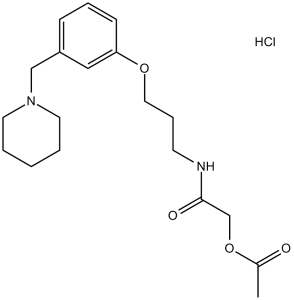Roxatidine acetate HCl (HOE 760)
This product is for research use only, not for human use. We do not sell to patients.

For small sizes, please check our retail website as below: www.invivochem.com
| Size | Price | Stock |
|---|---|---|
| 2g | $180 | Check With Us |
| 5g | $299 | Check With Us |
| 10g | $445 | Check With Us |
Cat #: V1229 CAS #: 93793-83-0 Purity ≥ 98%
Description: Roxatidine Acetate HCl (HOE-760; TZU0460; HOE760; TZU-0460; Gastralgin; Altat; Roxit), the hydrochloride salt of Roxatidine Acetate, is a specific and competitive histamin H2-receptor antagonist with antiulcer activity.
Top Publications Citing Invivochem Products
Publications Citing InvivoChem Products
Product Promise

- Physicochemical and Storage Information
- Protocol
- Related Biological Data
- Stock Solution Preparation
- Quality Control Documentation
| Molecular Weight (MW) | 384.9 |
|---|---|
| Molecular Formula | C19H28N2O4.HCl |
| CAS No. | 93793-83-0 |
| Storage | -20℃ for 3 years in powder formr |
| -80℃ for 2 years in solvent | |
| Solubility In Vitro | DMSO: 77 mg/mL (200.1 mM)r |
| Water: 77 mg/mL (200.1 mM)r | |
| Ethanol: 12 mg/mL (31.2 mM) | |
| Synonyms | HOE 760; TZU 0460; HOE-760; TZU0460; HOE760; TZU-0460; Roxatidine Acetate Hydrochloride; Gastralgin; Altat; Roxit |
| Protocol | In Vitro | Roxatidine Acetate Hydrochloride (6.25 μM, 12.5 μM, and 25 μM; pre-treatment for 30 min) suppresses the PMACI-induced activation of p38 MAPK, but does not affect the phosphorylation of ERK or JNK. The total ERK 1/2, JNK, and p38 MAPK levels are unaffected by roxatidine in human mast-cells-1 (HMC-1) cells |
|---|---|---|
| In Vivo | Roxatidine Acetate Hydrochloride (oral gavage; 20 mg/kg; single dose) inhibits Compound 48/80-increased TNF-α, IL-6, and IL-1β production and mRNA expression. Additionally, Roxatidine Acetate Hydrochloride decreases the compound 48/80-induced degradation of procaspase-1 and appearance of the corresponding cleaved bands in mice |
These protocols are for reference only. InvivoChem does not
independently validate these methods.
| Solvent volume to be added | Mass (the weight of a compound) | |||
|---|---|---|---|---|
| Mother liquor concentration | 1mg | 5mg | 10mg | 20mg |
| 1mM | 2.5981 mL | 12.9904 mL | 25.9808 mL | 51.9615 mL |
| 5mM | 0.5196 mL | 2.5981 mL | 5.1962 mL | 10.3923 mL |
| 10mM | 0.2598 mL | 1.2990 mL | 2.5981 mL | 5.1962 mL |
| 20mM | 0.1299 mL | 0.6495 mL | 1.2990 mL | 2.5981 mL |
The molarity calculator equation
Mass(g) = Concentration(mol/L) × Volume(L) × Molecular Weight(g/mol)
Mass
=
Concentration
×
Volume
×
Molecular Weight*
The dilution calculator equation
Concentration(start)
×
Volume(start)
=
Concentration(final)
×
Volume(final)
This equation is commonly abbreviated as: C1 V1 = C2 V2
Concentration(start)
C1
×
Volume(start)
V1
=
Concentration(final)
C2
×
Volume(final)
V2
Step One: Enter information below
Dosage mg/kg
Average weight of animals g
Dosing volume per animal µL
Number of animals
Step Two: Enter the in vivo formulation
%DMSO
+
%
+
%Tween 80
+
%ddH2O
Calculation Results:
Working concentration:
mg/ml;
Method for preparing DMSO master liquid:
mg
drug pre-dissolved in
µL
DMSO(Master liquid concentration
mg/mL)
,Please contact us first if the concentration exceeds the DMSO solubility of the batch of drug.
Method for preparing in vivo formulation:
Take
µL
DMSO master liquid, next add
µL
PEG300, mix and clarify, next add
µL
Tween 80,mix and clarify, next add
µL
ddH2O,mix and clarify.
Note:
- (1) Please be sure that the solution is clear before the addition of next solvent. Dissolution methods like vortex, ultrasound or warming and heat may be used to aid dissolving.
- (2) Be sure to add the solvent(s) in order.




































